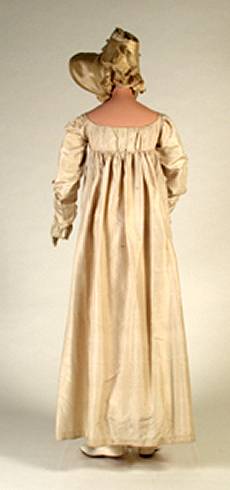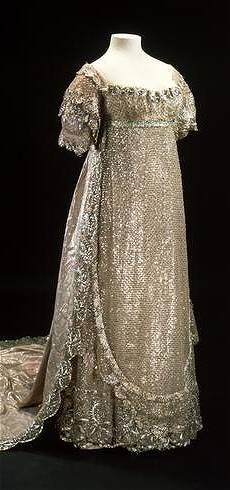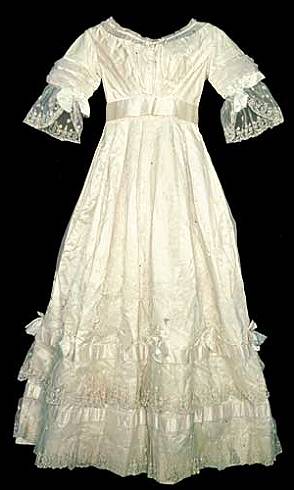|
Illustration:
17. Ivory Silk Taffeta Gown Unknown maker, Chillicothe, Ohio, 1817. Now in the collection of the Ohio Historical Society.
18. Schaffner Wedding Dress, 1824 (Marietta, Pennsylvania)
19. Princess Charlotte's wedding dress, 1816. Dress in the Museum of London
20. Emma Talbot's Wedding Dress of 18th June 1833, now in the collection of The Museum Stores at Landore in the Stores
21. 'Les Apprits D'un Mariage a Paris', 1823. Lithographer, Julien Vallou de Villeneuve.
22. Miss Stephens as Susanna in the Marriage of Figaro 1830-1834 by S.W. Reynolds
23. 'The Bridal Eve' Artist E.T. Parris, Engraver Thomson. Published by Peter Jackson, London & Paris, 1844
Notes on the text:
v: Princess Charlotte's Wedding gown, now in collection of the Museum of London. White silk net embroidered in silver strip with a spotted ground and borders. The wedding dress, composed of a most magnificent silver lama on net, over a rich silver tissue slip, with a superb border of silver lama embroidery at the bottom, forming shells and bouquets above the border; a most elegant fullness tastefully designed, in festoons of rich silver lama, and finished with a very brilliant rollio of lama; the body and sleeves to correspond, trimmed with a most beautiful point Brussels lace, in a peculiar elegant style. The manteau of rich silver tissue lined with white satin, trimmed round with a most superb silver lama border, in shells to correspond with the dress, and fastened in front with a most brilliant and costly ornament of diamonds. The whole dress surpassed all conception in the brilliancy and richness of its effects. Head dress, a wreath of rose buds and leaves, composed of the most superb brilliants. Description of Princess Charlotte's Wedding from the May 1816 issue of The Lady's Magazine.
w: Ivory Silk Taffeta Gown Unknown maker, Chillicothe, Ohio, 1817. Worn by Anne Catherine Spurck of Chillicothe, Ohio, to her marriage with Peter Dittoe of Somerset, Ohio, on July 4, 1817. Collection of the Ohio Historical Society, H40010.
x: Schaffner Wedding Dress, 1824 (Marietta, Pennsylvania) Ivory silk with drawstring ties at neck and waist. More photos of the wedding gown
y: 'Emma Talbot's Wedding Dress,' now in the collection of The Museum Stores at Landore in the Stores: "At Penrice Castle on 18th June 1833, Rev. Henry Strangways conducted the marriage of Emma Thomasina Talbot, daughter of Thomas Mansel Talbot to John Dillwyn Llewelyn, eldest son of Lewis Weston Dillwyn. This is the beautiful dress that Emma wore on that auspicious day. Made of cream silk satin covered with cream silk net, the dress measures just 122cm (48ins) from neck to hem, Emma must have been extremely petite. It is decorated with satin ribbon and intricate embroidery. The design of the dress is historically important in as much as it heralds the change from the Regency to the Victorian style."
z: 'Les Apprits D'un Mariage a Paris' Galerie lithographiče de son Altesse royale Monseigneur le Duc d'Orlčans. Lithographer, Julien Vallou de Villeneuve. Printer, Charles Etienne Pierre Motte 1823.
aa: Miss Catherine (Kitty) Stephens, (1794-1882), Countess of Essex, the daughter of Edward Stephens of Leadwell, Oxfordshire, a carver and gilder of London. She was said to have had the sweetest soprano voice of her time, both in opera and as a concert singer. She was a famous vocalist and actress, who in 1813, at the age of 19, made her debut at Covent Garden. She was scandalously married to George Capell Coningsby, the 5th Earl of Essex, on 14 April 1838. He was aged 80, she was 44. They were married by special licence at the Earl's house in Belgrave Square, London, and honeymooned at Cassiobury. She died on 22 Feb 1882, aged 87
bb: Playbill advertising Miss Stephens and Miss Johnstone in THE MARRIAGE OF FIGARO, with Mr. Simpson and his dogs in THE DOG OF MONTARGIS, at the Theatre Royal, Birmingham, 30 July 1827. Theatre Royal, New Street, Birmingham, Warwickshire, England
|






